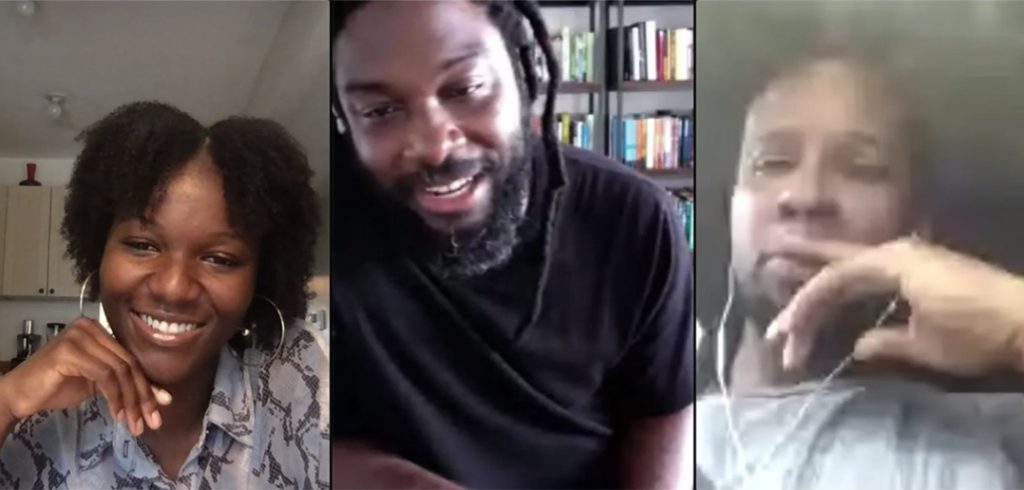Reynolds was one of the keynote speakers at the Bronx Book Festival produced by The Bronx Is Reading, and co-sponsored by Fordham’s Office of the Chief Diversity Officer. The festival normally takes place on Fordham Plaza across the street from Fordham’s Rose Hill campus, but this year it was held virtually on June 5 due to the pandemic.
For Reynolds’ session, he was in conversation with author Ibram X. Kendi, Ph.D., professor of history and international relations and the founding director of the Antiracist Research and Policy Center at American University. Bronx native Lovia Gyarkye, associate editor at New York Times Magazine Labs, moderated.
Kendi’s National Book Award-winning Stamped from the Beginning: The Definitive History of Racist Ideas in America (Bold Type Books, 2016) examines how racism shaped five historical figures—from abolitionist William Lloyd Garrison to activist Angela Davis. The book portrays its subjects in the harsh light of truth, rather than a heroic glow.
In response to the need for middle school history books that address how racism shapes lives, Kendi tapped Reynolds to help in a retelling of his book for young people. The result was Stamped: Racism, Antiracism, and You (Little, Brown Books for Young Readers, 2020), which is described as a “remix and NOT a history book,” so as to not scare off young readers who might otherwise turn their nose up at a history lesson.
The adult book sets out to define the terms of where people land on the racism spectrum. There are three archetypes, writes Kendi: the segregationists, the assimilationists, and the anti-racists. In the young adult book, Reynolds calls them the haters, the likers, and the lovers.
“Everybody knows a hater,” said Reynolds. “But here, [the hater]is a racist that is overtly separatist due to the color of your skin. The likers are people who walk with you as long as you act like them. And the [lovers are]anti-racist people who believe that all people are equal, a basic level of equality for all humanity; these are the people who love us. This was the architecture to frame the discussion.”
Both authors said that they did not have the most engaging experiences as young people in history classes, in part because the text assumed that young people would be inherently interested, rather than doing the hard work of pulling the reader into the story.
“Jason liberated himself and the young readers by saying this is not a history book,” said Kendi.
Unvarnished Heroes
Both the adult and young adult versions also avoid a common trope in historic biographies by exposing the subjects’ human complexities.
“One of the things we do with ourselves and people we admire is we deny that we did wrong or our heroes did wrong,” said Kendi.
As it would turn out, some abolitionists could have been mere “likers.”
“We wanted to define terms of racism and looked for people who defined those terms, and even if it was someone who we admired, we were going to hold fast to that definition,” he said.
Humans, he said, have good qualities and not-so-good qualities.
“If we honor their legacy in its totality we have to look at the whole picture,” said Reynolds, “not just what they were doing then, but in our present history as citizens.”
Demonstrations and Examining the White Self
The authors then took the same approach when they discussed white people participating in present-day protests sparked by the death of George Floyd at the hands of police.
“There’s something going on with white folks; I don’t pretend to know what it is, because I’m not white,” said Reynolds, stressing that conversations need to be had around self-interest. He said an underlying motivator for white demonstrators could well be the need to relieve shame and guilt.
He also stressed the need for white people to do the work and educate themselves about racism.
“You have to work for it,” Reynolds said, adding that the process should not be rushed. “Pace yourself, because if you want to do less harm, slow down. Don’t go trying to save the world. Slow down and save your family. Work on yourself and what’s happening in your household. Read with your spouses and your parents. Figure out how to have different conversations.”
Kendi added that through the demonstrations, white people were being radicalized by seeing first-hand the unchecked police aggression.
“They never had to feel what it is to be Black in this country, which is to be constantly terrorized by police violence, but white people went out there to demonstrate against police violence and they suffered police violence, so they came face-to-face with precisely what they were demonstrating against and then their parents came face-to-face with that, their friends came face-to-face with that, their whole community came face-to-face with that,” he said.


